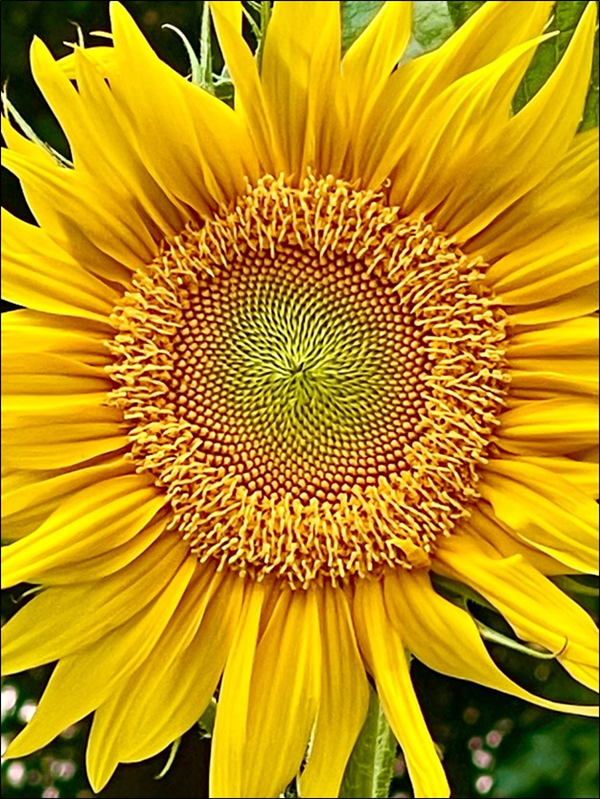 Photo credit: Don Lilleboe
Photo credit: Don Lilleboe
Note: As mentioned elsewhere in this issue of The Sunflower, the USDA 2025 crop production report being released as of November 14 did not include any numbers for sunflower. Those numbers, in all likelihood, will not be available until January.
With that in mind, we conducted a very informal inquiry of several sunflower producers (and one extension specialist, Ron Meyer of Colorado) from around the sunflower growing region to get an idea of how the crop fared in 2025. Summaries of their responses are provided below. Our thanks to them for their input!
South central North Dakota producer Adam Bettenhausen of Wishek reports that sunflower acreage was up substantially this year compared to 2024 — probably approaching the average of the past several years. “We had a very wet and cool growing season, which seemed most beneficial,” he says. “We experienced typical blackbird and weevil damage for the area, and we also saw some Sclerotinia head rot — although a dry end to August saved us from a total outbreak.”
Based on his own farm and conversations with neighbors, Bettenhausen characterizes 2025 yields as “mostly good, although not as good as many were hoping.” In the end, he predicts, most of the area’s sunflower crop will end up in the 2,000- to 2,500-lb/ac range with oil contents between 41 to 45%.
In southeastern North Dakota, a producer (who prefers to not be identified by name) indicates that sunflower acre-age in his vicinity was up this year from 2024. There was a significant amount of Phomopsis in 2025. Final yields ranged from 1,700 lbs/ac up to 2,900 lbs, he estimates, with lots of variability due to late planting, relative rainfall amounts and disease.
In northeastern North Dakota, Paul Boesl of Langdon says 2025 definitely brought more sunflower acres to his area compared with the prior year. “Producers looked at the bottom line, and sunflower looked to be a very good money maker,” he notes. Most area sunflower fields looked very good until mid-autumn, when foggy and wet mornings arrived. That in turn brought disease issues and then heavy winds, which blew over a lot of plants.
“Early yields were above 3,000,” Boesl says, while later-harvested fields were in the 1,500- to 2,000-lb range. As of the 1st of November, “what’s left out there now to be harvested will be well below 1,500,” he ventures. “Mother Nature has been cruel. We are very wet now.”
Tom Dowdle was still harvesting soybeans as of the second week of November, needing to get the beans off before heading into his standing sunflower fields.
A very wet autumn in his part of northwestern Minnesota really impacted the Kennedy, Minn., producer’s harvest schedule. He is a sugarbeet grower as well, and the beets had to be dug under difficult field conditions before he could turn to beans.
Spring planting in Dowdle’s area was timely due to favorable weather, and his sunflower crop progressed well throughout the season. While the very wet fall and accompanying “horrendous winds” resulted in some plant lodging along field edges, Dowdle still anticipated very satisfactory results. Some of his neighbors garnered sunflower yields around 2,500 lbs, and he was optimistic of also ending up in that range.
In central South Dakota, Chuck Todd of Onida reports improved sunflower results compared to 2024. The National Sunflower Association president says acreage in his area was probably about double that of last year — a year in which Sully County dropped by about two-thirds from 2023 (largely due to severe seed weevil infestations).
“The [2025] growing season was slow to start, but moisture came at a good enough pace to produce a better crop than last year,” Todd says. Red seed weevil levels were high this season, but control was better compared to the prior year. He was aware of yields ranging from 2,000 all the way up to 3,500 lbs/ac as of the end of October.
Heading into the High Plains, Cameron Peirce of Hutchinson, Kan., reports 2025 sunflower acreage up by perhaps as much as 80% versus the prior season. “The growing season for all our crops has been fantastic” he re-ported in late October. “Plenty of moisture and great temps.” Peirce reports “persistent” sunflower head moth populations in his south central Kansas area in 2025.
In the end, full-season dryland sunflower yields averaged in the 2,000- to 2,500-lb/ac range, Peirce estimates, with irrigated ’flowers running as high as 4,000 lbs. Some full-season sunflower oils ran as high as 47%.
As of the end of October, south central Kansas producers were anxious to get any remaining double-cropped ’flowers harvested. “The longer they stay in the field, the higher the chance of lodging,” Peirce acknowledges.
Ron Meyer is the longtime area extension agronomist for Colorado State University in east central Colorado, based at Burlington. He says sunflower acreage in his region was up slightly in 2025, mostly as a result of low wheat and corn prices. Also, “decent oil contracts were available this spring, and more growers contracted them.”
East central Colorado received better-than-average mid-season moisture, Meyer notes. As a result, “both sunflower yields and oil percentages are expected to be above average,” he reported in late October.
Head moth populations in area sunflower fields were above average in 2025, while seed weevil infestations were below normal. “We still have a few Dectes and stem weevil, but those populations have been manageable,” Meyer adds.
Most sunflower in east central Colorado district is dryland, with this year’s estimated yields ranging from 1,500 lbs/ac (normal) up to 2,500 lbs. “Most oils are above 40%, so premiums will be welcome,” Meyer notes. “One grower had 48% oil — which is rare for us.”
The welcome mid- and late-season rains translated into above-average sunflower yields overall, with higher-than-average oil contents. “This year, the sunflower crop will out-produce dryland corn, economically, by quite a bit,” Meyer observes. He expects slightly higher sunflower acreage again in 2026. —Don Lilleboe